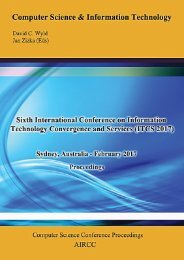CoSIT 2017
Fourth International Conference on Computer Science and Information Technology ( CoSIT 2017 ), Geneva, Switzerland - March 2017
Fourth International Conference on Computer Science and Information Technology ( CoSIT 2017 ), Geneva, Switzerland - March 2017
You also want an ePaper? Increase the reach of your titles
YUMPU automatically turns print PDFs into web optimized ePapers that Google loves.
108 Computer Science & Information Technology (CS & IT)<br />
6 * 10 * 14 * 18 / 2 L-1 , where L = the size of the set. (7)<br />
For this case L = 4, so M = 1890 .<br />
That means any number in the range [ 0 – 1889 ] has a unique representation among the proposed<br />
set. This dynamic range is larger than the range for { 2 n1 – 2, 2 n1 , 2 n1 + 2 } which equals 120.<br />
i.e. 1890 >> 120.<br />
It is also having a larger range than the set { 2 n2 – 2, 2 n2 , 2 n2 + 2 } which has M = 1008.<br />
i.e. 1890 > 1008.<br />
This is due we are working with 4-moduli set rather than 3-moduli set, and by neglecting the<br />
middle modulus ( i.e. 2 n ) and having the conjugate of n1 , n2 instead. Mathematically it could<br />
be shown as :<br />
M1 = 6 * 8 *10 / 4 , M2 = 14 * 16 * 18 / 4 while M3 = 6 * 10 * 14 * 18 / 8 .<br />
Take for M2 case, as it has larger numbers than M1, 16 / 4 < 6 * 10 / 8 or by having 6 * 10 / 2 =<br />
30, 30 > 16 when comparing them divided 4 ( i.e. having a common base of comparison ).<br />
The conversion process works as the follow, each modulus having the shape 2 n – 2 goes to<br />
Converter number 1, while the 2 n + 2 goes to Converter number 2 that works in parallel.<br />
Converter 1 does its work just as figure 1 in [2] showed, figure 2 in the same paper shows<br />
converter 2 work.<br />
Hardware implementation for each case is shown in figures 3, 5 of [2].<br />
3.2 VALUE SET OF 6-MODULUS<br />
When we take N = 3, then the multi-moduli set will be on the form :<br />
S = { 2 n1 – 2, 2 n1 + 2, 2 n2 – 2, 2 n2 + 2, 2 n3 – 2, 2 n3 + 2 }.<br />
If we take n1 = 3 , n2 = 4 and n3 = 5 for simplicity. The shape of the set is :<br />
S2 = { 6, 10, 14, 18, 30 , 34 }.<br />
M ( i.e. Dynamic Range of the set ) is calculated through the LCM. For the set S2 it is equal to<br />
6 * 10 * 14 * 18 * 30 * 34 / 2 L-1 , where L = the size of the set. (8)<br />
For this case L = 6, so M = 481950.





